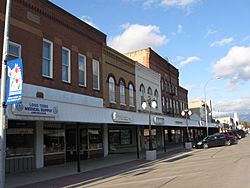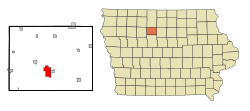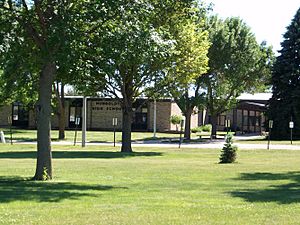Humboldt, Iowa facts for kids
Quick facts for kids
Humboldt, Iowa
|
|
|---|---|

Streetside in Humboldt
|
|

Location of Humboldt, Iowa
|
|
| Country | |
| State | |
| County | Humboldt |
| Established | 1863 |
| Area | |
| • Total | 4.68 sq mi (12.13 km2) |
| • Land | 4.53 sq mi (11.73 km2) |
| • Water | 0.15 sq mi (0.40 km2) |
| Elevation | 1,083 ft (330 m) |
| Population
(2020)
|
|
| • Total | 4,792 |
| • Density | 1,058.07/sq mi (408.54/km2) |
| Time zone | UTC-6 (Central (CST)) |
| • Summer (DST) | UTC-5 (CDT) |
| ZIP code |
50548
|
| Area code(s) | 515 |
| FIPS code | 19-37560 |
| GNIS feature ID | 0457717 |
| Website | http://www.ci.humboldt.ia.us/ |
Humboldt is a city located in Humboldt County, Iowa, in the United States. In 2020, the city had a population of 4,792 people. This was a small increase of 102 people since the 2010 census.
Contents
History of Humboldt
Early Settlements and Fort Confederation
The area near present-day Humboldt was once home to ancient villages and Dakota Indian tribes. These settlements were located close to where two parts of the Des Moines River meet. During the 1800s, as people moved west, a fort and trading post called Fort Confederation might have been in this area.
In 1825, permission was given to build a fort here. Its purpose was to trade with the Yankton Sioux Indians. However, many details about this fort are still unclear. For example, we don't know if American, French Canadian, or Métis traders built it.
Founding of Springvale
The person who founded modern Humboldt was Stephen Harris Taft. He planned the town in 1863 and first named it Springvale. The name came from the many natural springs found near the Des Moines River. Taft had big dreams for this new community. He hoped many smart people from the East would move there.
Taft had five main goals for his ideal town:
- The town should be surrounded by and full of trees and forests.
- No alcoholic drinks should be sold in the town.
- The town should be built around a sawmill and a grist mill on the Des Moines River.
- The town should have strong churches and good schools. It should become a place for thinkers and beauty.
- The town should grow to have an important college or university. Its church should stay united.
Taft worked hard to turn the empty prairie into his dream community. In 1863, he brought a group of settlers, including a doctor. They lived in the few houses that had been built. The grist mill, now known as the Corydon Brown House, was also built. Taft wanted very wide streets throughout the town, and Humboldt is still known for them today.
Renaming and Challenges
Springvale was later renamed Humboldt. This new name honored the German explorer and naturalist Alexander von Humboldt. The hope was that Springvale would merge with Dakota City, which was the county seat. However, this merger never happened. This was one of the first big challenges that stopped Humboldt from reaching all of Taft's goals.
Another challenge came with the idea of a college. In 1866, a group called the Springvale Collegiate Association was formed by Taft. After a flood in 1867 damaged the town's dam, the idea of a college became popular again in 1869. The association changed its name to the Humboldt Collegiate Association. People were very excited about the college. However, when the county's voters were asked to approve land for a Northern Iowa College in October 1869, they voted against it.
Taft did not give up. He looked for money from the East. Even after almost missing a payment deadline, Taft started building the college on June 17, 1870. He believed that many people would gather there in the future to celebrate the college.
Humboldt College
Humboldt College opened its doors on September 13, 1872. The first three years were for preparing students, like extra lessons after eighth grade. The next four years were for college-level studies. In June 1879, the first three students graduated. They were the only ones ever to get a degree from the college.
Around this time, Taft and the college faced money problems. It was hard to raise enough money to support Taft's big vision. After some tough financial times, the college closed in 1916. The building was torn down in 1926 because no one could rent it. Without the college, Taft's dream of Humboldt becoming a major center for knowledge could not come true.

Later Events
In July 1955, Humboldt had a special visit. A group of officials from the Soviet Union came to stay overnight. This was unusual because contact between Americans and Soviets was rare back then. Many national and international reporters also came to see this glimpse of rural American life.
On March 27, 1972, a TV show called "A Small Town in Iowa" was broadcast by ABC-TV. It was made by Andy Rooney and narrated by Harry Reasoner, who grew up in Humboldt. The show showed Humboldt as a wonderful place. However, it also talked about how the town struggled to keep its talented young people from moving to bigger cities. The show wondered why "paradise" might not appeal to bright kids. The answer suggested was that people with big goals might not be happy performing for a small audience.
Geography
Humboldt is located at 42°43′25″N 94°13′17″W / 42.72361°N 94.22139°W. The city covers about 4.80 square miles (12.43 square kilometers). Most of this area, about 4.64 square miles (12.02 square kilometers), is land. The rest, about 0.16 square miles (0.41 square kilometers), is water.
Humboldt County is part of a flat area called the Des Moines Lobe. This area was shaped by glaciers long ago. Today, it is mostly used for farming. The land is mostly flat or gently rolling. There are some hills and dips left by the glaciers. Unlike some other parts of Iowa, this area does not have loess deposits.
The rivers and streams here are not very developed. Major rivers have carved deep valleys. Most of Iowa's natural lakes are found in the northern part of this region. Many natural lakes have been drained for farming. This was done using drainage tiles or ditches. Only a small part of the original wetlands remain.
Climate
Humboldt has a humid continental climate. This means it experiences all four seasons. Winters are cold, springs are wet, summers are hot, and autumns are fairly short. Temperatures can change a lot in this climate zone.
| Climate data for Humboldt, Iowa | |||||||||||||
|---|---|---|---|---|---|---|---|---|---|---|---|---|---|
| Month | Jan | Feb | Mar | Apr | May | Jun | Jul | Aug | Sep | Oct | Nov | Dec | Year |
| Record high °F (°C) | 63 (17) |
70 (21) |
−22 (−30) |
3 (−16) |
19 (−7) |
34 (1) |
37 (3) |
34 (1) |
21 (−6) |
−2 (−19) |
−14 (−26) |
−25 (−32) |
70 (21) |
| Mean daily maximum °F (°C) | 25 (−4) |
31 (−1) |
44 (7) |
59 (15) |
72 (22) |
81 (27) |
84 (29) |
81 (27) |
74 (23) |
62 (17) |
43 (6) |
29 (−2) |
57 (14) |
| Mean daily minimum °F (°C) | 7 (−14) |
14 (−10) |
25 (−4) |
37 (3) |
49 (9) |
58 (14) |
62 (17) |
60 (16) |
50 (10) |
38 (3) |
25 (−4) |
12 (−11) |
36 (2) |
| Record low °F (°C) | −42 (−41) |
−33 (−36) |
— | — | — | — | — | — | — | — | — | — | −42 (−41) |
| Average precipitation inches (mm) | 0.88 (22) |
0.80 (20) |
2.16 (55) |
3.28 (83) |
3.89 (99) |
4.79 (122) |
4.29 (109) |
4.12 (105) |
2.95 (75) |
2.28 (58) |
1.74 (44) |
1.07 (27) |
32.25 (819) |
| Source: The Weather Channel | |||||||||||||
Demographics
| Historical populations | ||
|---|---|---|
| Year | Pop. | ±% |
| 1870 | 335 | — |
| 1880 | 606 | +80.9% |
| 1890 | 1,075 | +77.4% |
| 1900 | 1,474 | +37.1% |
| 1910 | 1,809 | +22.7% |
| 1920 | 2,232 | +23.4% |
| 1930 | 2,251 | +0.9% |
| 1940 | 2,819 | +25.2% |
| 1950 | 3,219 | +14.2% |
| 1960 | 4,031 | +25.2% |
| 1970 | 4,665 | +15.7% |
| 1980 | 4,794 | +2.8% |
| 1990 | 4,438 | −7.4% |
| 2000 | 4,452 | +0.3% |
| 2010 | 4,690 | +5.3% |
| 2020 | 4,792 | +2.2% |
| Source: and Iowa Data Center Source: |
||
2020 Census Data
In 2020, Humboldt had 4,792 people living in 2,051 households. There were 1,234 families. The population density was about 1,058 people per square mile. There were 2,256 housing units.
Most of the people in Humboldt were White (91.7%). Other groups included Black or African American (0.9%), Native American (0.1%), and Asian (0.3%). About 4.0% were from other races, and 3.0% were from two or more races. People of Hispanic or Latino background made up 6.3% of the population.
About 26.9% of households had children under 18. Many households (48.2%) were married couples. The average age in the city was 40.7 years. About 26.5% of residents were under 20 years old. About 23.4% were 65 years or older. The population was 48.0% male and 52.0% female.
2010 Census Data
In 2010, Humboldt had 4,690 people living in 2,091 households. There were 1,250 families. The population density was about 1,010 people per square mile. There were 2,246 housing units.
Most of the people in Humboldt were White (94.9%). Other groups included African American (0.6%), Native American (0.1%), and Asian (0.4%). About 3.0% were from other races, and 0.9% were from two or more races. People of Hispanic or Latino background made up 5.0% of the population.
About 24.9% of households had children under 18. Many households (48.2%) were married couples. The average age in the city was 45.3 years. About 22.4% of residents were under 18 years old. About 24.5% were 65 years or older. The population was 47.7% male and 52.3% female.
Education
The Humboldt Community School District manages the public schools in Humboldt. The city has several schools:
- Mease Elementary School (located in Dakota City)
- Taft Elementary School
- Humboldt Middle School
- Humboldt High School
Notable People
- G. Duncan Bauman (1912–2003) - A newspaper reporter, editor, and publisher.
- Jack Clancy - A football player for the Miami Dolphins.
- Christian Clemenson - An Emmy Award-winning actor.
- Kevin Dresser - A head wrestling coach at Iowa State University and a national wrestling champion.
- Theodore G. Garfield - A long-serving justice of the Iowa Supreme Court.
- Frank A. Gotch - A world heavyweight wrestling champion from 1908 to 1915.
- Frank A. Gotch (MD) - An American doctor who created important formulas for kidney dialysis.
- L. W. Housel - A former Connecticut State Legislator and a candidate for governor of Iowa.
- Byron McKeeby - An American artist and educator.
- John H. Mitchell (1899–1992) - An Iowa state representative and attorney general.
- Jon Porter - A U.S. Representative from Nevada.
- Harry Reasoner - A famous CBS and ABC news correspondent and TV host.
- Bruce Reimers - An NFL offensive guard for the Cincinnati and Tampa Bay teams.
- Dick Schultz - A college sports coach and executive director of the United States Olympic Committee.
See also
 In Spanish: Humboldt (Iowa) para niños
In Spanish: Humboldt (Iowa) para niños



